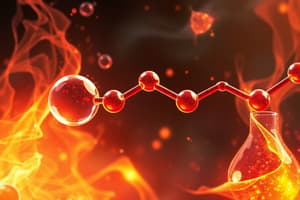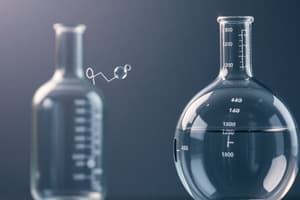Podcast
Questions and Answers
Which functional group is characterized by the presence of a carbonyl group (C=O) bonded to a hydroxyl group (–OH)?
Which functional group is characterized by the presence of a carbonyl group (C=O) bonded to a hydroxyl group (–OH)?
- Ketone
- Ester
- Aldehyde
- Carboxylic acid (correct)
What is the primary difference between SN1 and SN2 reaction mechanisms?
What is the primary difference between SN1 and SN2 reaction mechanisms?
- SN1 has a carbocation intermediate, while SN2 does not. (correct)
- SN2 reactions are faster than SN1 regardless of conditions.
- SN2 reactions occur only in polar protic solvents.
- SN1 involves a single step, while SN2 involves two steps.
In stereochemistry, what defines a pair of enantiomers?
In stereochemistry, what defines a pair of enantiomers?
- Molecules that have the same molecular formula but different structural arrangements.
- Molecules that are identical in all respects but differ in spatial orientation.
- Molecules that contain a chiral center and have non-superimposable mirror images. (correct)
- Molecules that can be superimposed on their mirror images.
What technique would you use to identify the functional groups present in a compound?
What technique would you use to identify the functional groups present in a compound?
What does Markovnikov's Rule predict in organic reactions?
What does Markovnikov's Rule predict in organic reactions?
Study Notes
Key Concepts in Advanced Organic Chemistry
1. Functional Groups
- Importance: Determine reactivity and properties of organic molecules.
- Common groups: Alcohols, phenols, aldehydes, ketones, carboxylic acids, esters, amines, and ethers.
2. Reaction Mechanisms
-
Nucleophilic Substitution:
- Types: SN1 and SN2.
- Mechanism: Involves the attack of a nucleophile on an electrophile.
-
Elimination Reactions:
- Types: E1 and E2.
- Mechanism: Loss of atom(s) to form a double bond.
-
Addition Reactions:
- Characterized by the addition of molecules across a double bond (e.g., electrophilic add., nucleophilic add.).
3. Stereochemistry
-
Isomerism:
- Structural isomers vs. stereoisomers.
- Chirality: Molecules with non-superimposable mirror images (enantiomers).
-
R/S and E/Z Nomenclature:
- Assigning configurations based on Cahn-Ingold-Prelog rules.
4. Spectroscopy Techniques
-
NMR (Nuclear Magnetic Resonance):
- Techniques: 1H NMR and 13C NMR.
- Use: Determine structure, environment of hydrogen, and carbon atoms.
-
IR (Infrared Spectroscopy):
- Identifies functional groups based on vibrational transitions.
-
Mass Spectrometry:
- Measures mass-to-charge ratio to determine molecular weight and structure.
5. Synthesis Strategies
-
Retrosynthesis:
- Breaking down target molecules into simpler precursors.
-
Functional Group Interconversions:
- Modifications of functional groups to prepare desired compounds.
-
Organometallic Chemistry:
- Involves compounds with metal-carbon bonds, crucial for synthetic pathways (e.g., Grignard reactions).
6. Reaction Conditions
-
Catalysis:
- Role of catalysts in lowering activation energy and increasing reaction rates.
-
Solvents:
- Polar vs. non-polar solvents.
- Influence on reaction rates and mechanisms.
7. Important Theories and Principles
-
Markovnikov's Rule:
- Predicts outcomes of electrophilic addition to alkenes.
-
Hückel's Rule:
- Criteria for aromaticity (4n+2 π electrons).
8. Organic Reaction Types
-
Oxidation-Reduction:
- Transfer of electrons; identify agents involved.
-
Functional Group Transformations:
- Strategies to convert one functional group into another.
-
Cross-Coupling Reactions:
- Techniques like Suzuki and Heck couplings for forming C-C bonds.
9. Organic Materials
-
Polymers:
- Synthesis and properties of organic polymers.
-
Natural Products:
- Chemistry of compounds produced by living organisms, including terpenes and alkaloids.
10. Advanced Topics
-
Peptide and Protein Synthesis:
- Strategies for synthesizing peptides, including solid-phase synthesis.
-
Asymmetric Synthesis:
- Techniques to produce enantiomerically enriched compounds.
-
Green Chemistry:
- Principles aimed at reducing environmental impacts of chemical processes.
Summary
Advanced organic chemistry encompasses deeper insights into reactivity, mechanisms, stereochemical considerations, and synthesis strategies, along with modern analytical techniques essential for understanding and manipulating organic compounds.
Functional Groups
- Determine the reactivity and properties of organic molecules.
- Common examples include alcohols, phenols, aldehydes, ketones, carboxylic acids, esters, amines, and ethers.
Reaction Mechanisms
- Nucleophilic Substitution:
- Involves the attack of a nucleophile on an electrophile.
- Common types include SN1 and SN2.
- Elimination Reactions:
- Result in the loss of atoms to form a double bond.
- Common types include E1 and E2.
- Addition Reactions:
- Involve the addition of molecules across a double bond.
- Examples include electrophilic addition and nucleophilic addition.
Stereochemistry
- Isomerism:
- Differentiates between structural isomers and stereoisomers.
- Chirality:
- Refers to molecules with non-superimposable mirror images (enantiomers).
- R/S and E/Z Nomenclature:
- Systems used to assign configurations based on the Cahn-Ingold-Prelog rules.
Spectroscopy Techniques
- NMR (Nuclear Magnetic Resonance):
- Techniques include 1H NMR and 13C NMR.
- Used to determine the structure and environment of hydrogen and carbon atoms.
- IR (Infrared Spectroscopy):
- Identifies functional groups based on vibrational transitions.
- Mass Spectrometry:
- Measures the mass-to-charge ratio of molecules to determine molecular weight and structure.
Synthesis Strategies
- Retrosynthesis:
- Involves breaking down target molecules into simpler precursors.
- Functional Group Interconversions:
- Strategies for modifying functional groups to prepare desired compounds.
- Organometallic Chemistry:
- Involves compounds with metal-carbon bonds crucial for synthetic pathways (e.g., Grignard reactions).
Reaction Conditions
- Catalysis:
- Utilizes catalysts to lower activation energy and increase reaction rates.
- Solvents:
- Polar solvents and non-polar solvents influence reaction rates and mechanisms.
Important Theories and Principles
- Markovnikov's Rule:
- Predicts the outcome of electrophilic addition to alkenes.
- Hückel's Rule:
- Criteria for aromaticity (molecules with 4n+2 π electrons).
Organic Reaction Types
- Oxidation-Reduction:
- Involves the transfer of electrons and identifying the oxidizing and reducing agents.
- Functional Group Transformations:
- Strategies for converting one functional group into another.
- Cross-Coupling Reactions:
- Techniques like Suzuki and Heck couplings for forming C-C bonds.
Organic Materials
- Polymers:
- Focuses on the synthesis and properties of organic polymers.
- Natural Products:
- Explores the chemistry of compounds produced by living organisms, including terpenes and alkaloids.
Advanced Topics
- Peptide and Protein Synthesis:
- Strategies for synthesizing peptides, including solid-phase synthesis.
- Asymmetric Synthesis:
- Techniques for producing enantiomerically enriched compounds.
- Green Chemistry:
- Principles aimed at reducing the environmental impacts of chemical processes.
Studying That Suits You
Use AI to generate personalized quizzes and flashcards to suit your learning preferences.
Description
This quiz covers essential concepts in advanced organic chemistry, including functional groups, reaction mechanisms, and stereochemistry. Test your knowledge on various topics such as nucleophilic substitution, elimination reactions, and spectroscopy techniques. Perfect for advanced students in organic chemistry courses.




